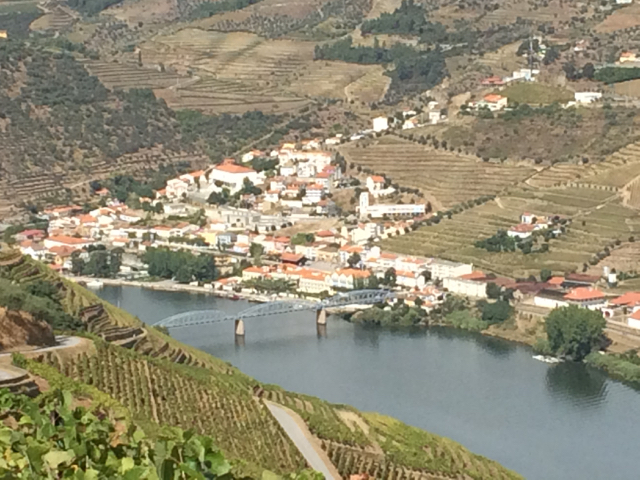
The small, rather rundown town of Pinhão in the Upper Douro
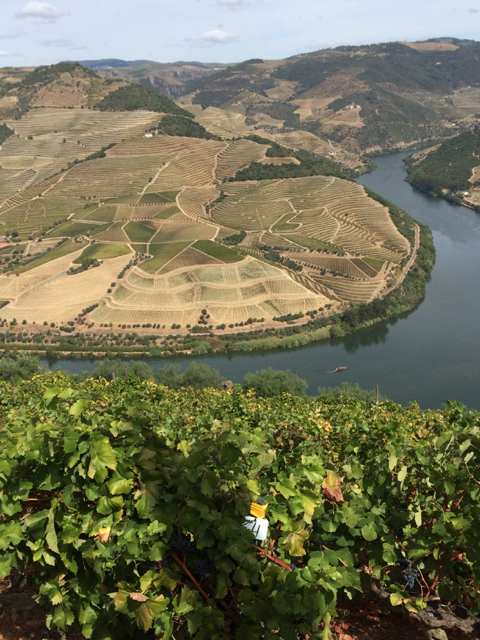
The Upper Douro – undoubtedly one of the world’s
most spectacular wine regions
It was back in August 1980 that CRM and I first passed through the Douro. We were heading back to the UK after a long summer holiday trip through France, Spain and Portugal, which included some rough camping on Portugal’s Atlantic coast – but that is another story. We drove through Pinhão headed that evening for Braganza.
This was pre-EU days in Portugal – before EU assistance and money transformed the country. I remember thinking we would drive towards Lisbon but soon gave up on the single carriageway road that included all forms of traffic including oxen pulling carts.
A little over a decade later when I had started to write about wine (from late 1988) I was invited to spend the weekend as part of a press at Taylor’s, which included a two-night stay at Quinta de Vargellas in the Upper Douro. We travelled up the Douro by train on the magical line that hugs the river – one of the great train journeys of the world starting from the highly atmospheric São Bento station in central Porto.
In those days in the early 1990s tourism in the Douro was hardly existed. There were few places to stay unless you were part of the wine trade or wine press, so were invited to stay in a quinta during the harvest.
A recent #winelover trip to Porto and the Douro underlined how much has changed. A new section of motorway has transformed the time it takes to get from Porto to the middle and upper Douro. It is now just an hour of 15/20 minutes from Porto to Régua. making day trips to the valley easy and practicable.
At the same time Porto itself has undergone a remarkable transformation in just a couple of years. Two years ago there were plenty of derelict buildings in the centre, Now that has all changed with fashionable shops and buzzy restaurants moving in and the town is packed with visitors.
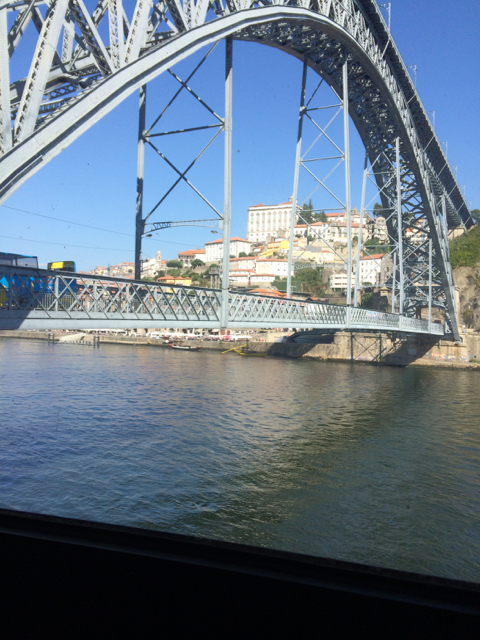
The iconic centre of Porto
(above and below)
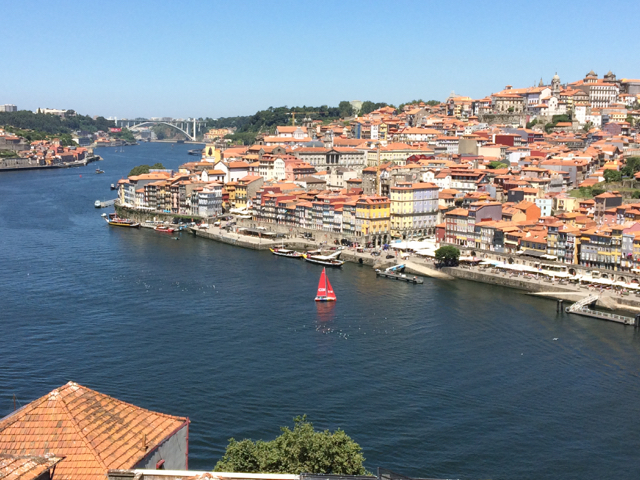
Port, of course is one of the attractions of coming to Porto and the Douro, although its importance has been a little diluted by the rising of the still wines of the Douro.
I have to confess that my feelings towards Port have long been rather ambivalent. Although I have been privileged to drink old Vintage Ports, which can be very fine, I find younger vintage Ports and LBVs etc. to be much less interesting than good Vins doux Naturels from the Roussillon be they Rivesaltes, Maury or Banyuls. I suspect that the genesis for Vintage Port was on the playing fields and dining rooms of English boarding schools.
Happily from recently spending generous amounts of time in Portugal – both in Porto and Lisbon – I have become increasingly enamoured with wood aged Ports – be they Tawnys or Colheitas, which I find have very considerably greater complexity and interest. Colheitas are single vintage wood aged Ports, while Tawnys are released as 10 YO, 20 YO, 30 YO, 40 YO – in the styles of where the average Port of of the stated age.
In September I was privileged to attend two remarkable Port tastings – one in Villa Nova de Gaia and the other at Niepoort up the Douro.
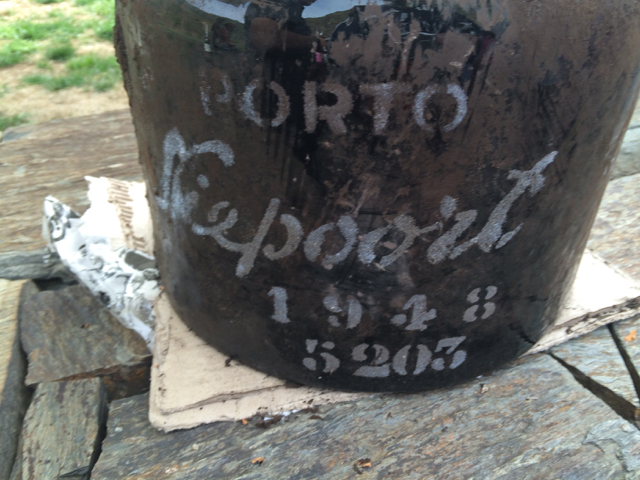
1948 Porto Niepoort
– a lovely complex treat
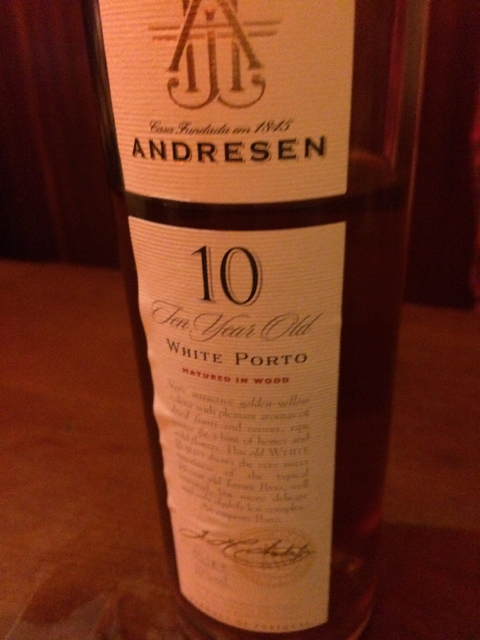
Finally the lovely Andresen 10 YO White Port is a reminder that these Ports can be complex and not just suitable for Port and tonic – refreshing as they are on a hot Douro day.
![]()
Movembre

Thanks for the trip, Jim. Would you say that Port has changed in style, over the years? Is the fact that many growers also sell Douro wine – or mainly sell Douro wine – an improvement factor for those who specialise in Port? And the fact that now Ports do not have to be aged far from the vineyard?
J’aimeJ’aime
Hervé. It is certainly exciting to see small independent growers such as Quevedo able to sell their own Port following the lifting of the ban on exporting Port from the Douro. One of the advantages of Portugal joining the EU….. Doubtless this has also stimulated Douro tourism along with the growth of still red and white Douro wines.
J’aimeJ’aime
Jim,
My experience with Ports of all kinds is at the same time much older and also 10 years younger than your trip there in the early eighties. My grandmother brought me up – as a matter of fact “let me grow” rather than educated me – and she was an ex-school teacher. When I first went to school, I could already read and my taste buds were quite well developed. What I lacked were social skills. It hasn’t changed much since then. I’m well read and a table-lover, but not much of a calm and collected bourgeois citizen. Amongst other things, she introduced me to tawny port, aged most of the time. Vintage was “not the drunk thing” in Belgium in those days.
Arrived Europalia 1991 and the very active promotion made by ICEP in Brussels, under the leadership of brilliant Luísa Cálem who was the “civil servant” in charge. So it happened my masters, teachers, lecturers (on the spot) became Dirk van der Niepoort, João Almeida, the late Arnold Gilbert, Francisco de Olazabal, David Guimarães etc … To tell the truth, I also had contact with the Symington clan but, kind as they were, and helpful during my trips, they have not been as seminal to my early knowledge. Later on, Maria Assunção Cálem, Christian Seely and the late Dieter Bohrman also catered a lot for me and helped me through my discoveries. Finally, I was one of the lucky invitees to the Tasting of the Century (more than 100 old vintages avalaible to assess). So MY genesis of Vintage Port has got nothing to do with boarding schools but with the glorious reality of schistous Cima Corgo, of basaltic Quinta do Vesuvio (almost Aberdonian !) and of almost-Spanish Ervamoira. I still love old vintages, and I’m sorry most brands (including those under Spanish bank control) are now making “vintage to be drunk young”, for obvious financial reasons. On the other hand, aged tawnies, and especially Colheitas amongst them, are probably my favorites, thanks to their complexity, perfect balance between sweetness and acidity and ever-lasting aftertaste.
I am, as you know, a fortified-winemaker myself now. But the dispute about which is the greatest – a silly one anyway – cannot be settled. Over the period of two weeks, I was lucky enough to taste (and sip and swallow, sometimes even gulping down) three madeiras (Terrantez, Malvasia & Verdelho), one Marsala, two Jerez (Oloroso), two Rivesaltes rancio and 5 or 6 Ports, starting way back in 1903. I cannot decide which one was the best. It doesn’t matter: pure gold all of them.
J’aimeJ’aime